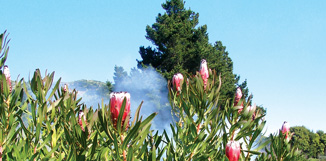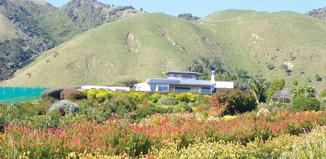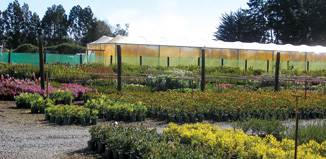Dense, bright green shrubs covered in oleander-type leaves, and splashed with sugary-pink, black-fringed flower domes were a common sight in our gardens during the 1970s, and earlier. A member of the Protaeceae family – there are currently some 73 genera, and more than 1,5000 species, Protea neriifolia, was New Zealand’s most well-known protea in cultivation.
“Newer cultivars now compete for popularity.” says grower Geoff Jewell, who owns and operates Te Horo Ornamentals, a nursery specialising in the Protaeceae family.
“Many people don’t realise the vastness and variety of the Protaeceaea family – the vivid orange or yellow leucospermums, the leucadendrons with their colourful leaf bracts, and their Australian cousins, the brilliant- red, club-shaped waratahs (telopeas) and the banksias with their strange-looking cones. Grevillea and the macadamia nut tree are also proteas”.
The forerunner of today’s proteas existed some 80 million years ago. When the great southern landmass, Gondwanaland, broke up into drifting land masses – Australia, New Zealand, New Guinea, and many of the Pacific islands, it is believed the Proteaceae family was widely dispersed, then evolved to produce many diverse and geographically scattered genera.
Two New Zealand natives, Knightia excelsa, or rewarewa, and Torania toru are Proteaceaea relics of our Gondwanaland ancestry. Fossil pollen of other species has also been found here.
Geoff began his love affair with proteas while still at college. During school holidays he worked at Zenith Gardens, in Upper Hutt, and continued part-time until the mid 1970s.
“I thought proteas were interesting – stunning looking plants”.
Believing the Rangiteki area would be suited to the Protaeceae family, he set up a commercial protea growing business in 1976. Later, in 1992, the family moved the business to Te Horo, hoping for an environment more like the plant’s South African home.
“Proteas grow naturally on steep cliffs near the sea. Coastal roads in South Africa are often lined with sheer banks covered with proteas”.
Geoff says the relatively frost-free climate, free draining soils, the close proximity to the sea, and land contours of Te Horo provide “ideal conditions” for his plants.
“They thrive in stony, gravelly soil, quite a harsh growing environment”.
Te Horo Ornamentals is really two businesses – the nursery and propagation, and the cut flower farm “up the road” run by wife, Beth.
Geoff manages, and has a ‘hands on’ role in the nursery and propagation area. He is responsible for developing many new cultivars within the Proteceae family, such as Leucadendron ‘Pisa’, a female hybrid cultivar of L. floridum that originated in New Zealand in the late 1970s from seed imported by Geoff. Leucospermum ‘Flame’ is a cultivar originating in New Zealand in 1980 from L. linare seed imported by Geoff from South Africa.
More than 95% of Geoff’s production is cutting raised however – straight species grown from seed account for less than 5%. Kirstenbosch smoke discs are used to stimulate germination on proteas with hard coated seeds, although Geoff says some protea species have seeds that retain viability for many years.
Vegatative propagation, using cuttings to produce an identical plant to the parent, is the method favoured by most growers. Cuttings are taken in late spring and early autumn when new growth has advanced to semi-hardwood stage. Geoff uses cuttings taken from juvenile growing stock, and from field grown plants cultivated on the flower farm. Most cuttings are semi-ripe, though he says leucodendron taken early in the season, before the cutting firms, often root quicker than those cut later in the year.
Cuttings are inserted into trays and small plastic tubes with cut away bases.
“Protea are slow to root. They’re a difficult variety to propagate”.
Managing both humidity and water levels is critical, so each poly- house has irrigation lines set up over heated propagation benches. The bottom heat on the benches is set at 23 degrees Celsius.
Each bed receives two minutes of watering per day through summer, and Geoff also utilises fog and mist. Fog is preferred for grey and hairy foliaged species – it is capable of maintaining humidity without continually wetting foliage. Humidity levels are maintained at between 85 and 88%.
Potting composts are equal parts bark, peat and pumice. Good drainage (to prevent water-logging), and plenty of available oxygen at the root zone is essential.
Commercial flower growers took until the mid 1980s to appreciate the potential of proteaceous flowers. A handful of growers in South Africa and New Zealand quietly went about the business of selling flowers for decades before that, but momentum only gathered when flower markets in Europe, Japan and USA realised this “new crop” potential.
Plants for Te Horo Ornamentals commercial cut-flower farm are sourced from their nursery, and the farm sends 40,000 bunches and 6,000 posies to market each year. Beth says the market focus is predominately local, although some flowers are transported to Christchurch.
The farm is on a free-draining site where soil is poor and slightly acidic, and Beth says proteaceae would be an ideal solution for those on lifestyle blocks with similar conditions, and who wanted to crop flowers for sale.
“Good varieties to try are Leucadendron ‘Safari Sunset’, and Protea ‘Pink Ice’, both tough, hardy plants”.
Proteas demand plenty of sun however, and need more water than people are led to believe, particularly young plants.
“Regular irrigation during the first summers – deep watering every week is more beneficial than little and often. Established plants need less, but growers will obtain longer stems if they apply extra water during growing season”.
Most members of the Proteaceae family have a root system that enables them to grow in low nutrient soils. They dislike compost, and are likely to be harmed by the application of fertilisers, particularly those containing phosphate, which is toxic to proteas.
Proteas also resent root disturbance and will not transplant easily. Sites should be chosen carefully, and Beth suggests dotting a few species around to see how they go, before taking on the huge expense of large scale planting, irrigation work, and packing facilities.
Mass plantings should be fenced off from stock, and young plants need to be tip pruned to promote sturdy growth and branching.
“Mature bushes are generally pruned through picking. We remove spent flower heads and bracts to encourage vigorous new growth, lots of new flowering branches and bracts for following season”.
Block-owners looking at growing Proteaceaea for commercial purposes must accept the need for spraying. Fresh new growth, particularly in leucadendrons, is attractive as a nursery to leaf-roller caterpillars, who drill holes through the flower bracts. When the flower head opens, “it’s not a pretty sight, definitely not saleable”.
Proteas are also susceptible to Phytophthora cinnamomi, a soil- borne fungus that causes root rot and collapse of a number of types of plants, often in poorly drained soils, where it can spread downhill with the movement of water. This is a difficult fungus to control or eradicate, and many commercial growers use systemic fungicides and soil drenches to help control the problem.
The gentle slopes of the cut-flower farm are sunshine-bright as I leave. There are ribbons of spidery grevilleas, spiky leucodendron, pin-cushion leucospermums, soft golden- yellow cones of Banksia spinulosa, and feathery patches of bright green South African restio. Dominating the slopes are huge, white flowers – Protea cynaroides, ‘Arctic Ice’, national flower of South Africa.
For more information on protea cultivation, and commercial cut-flower farming contact:
South Island Protea Growers Association
Email: proteaassoc@hotmail.com
New Zealand Protea and Foliage Growing Association
Email: Geoff@TeHoro-protea.co.nz

